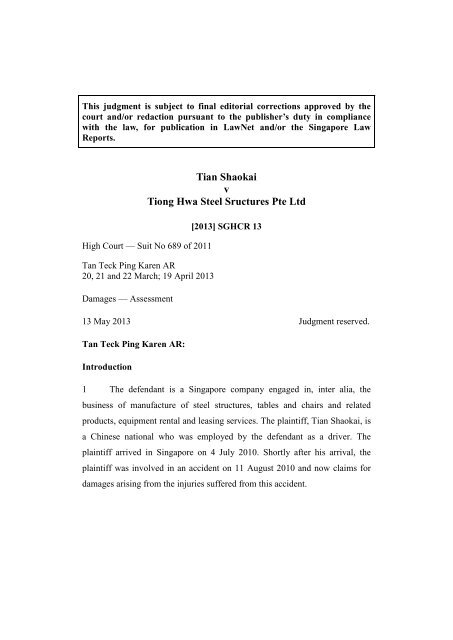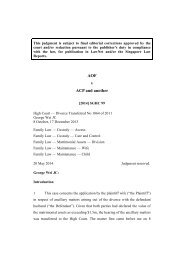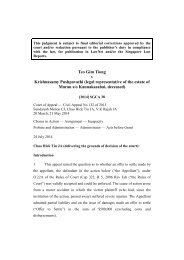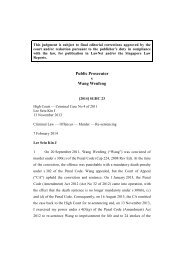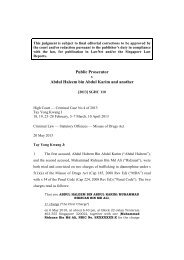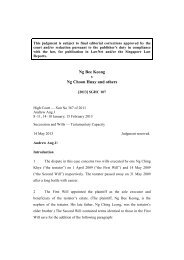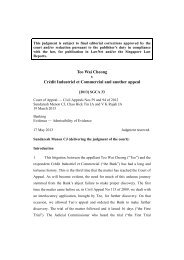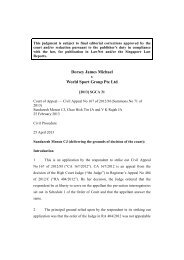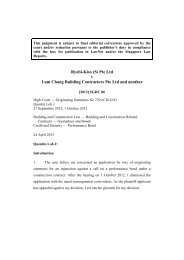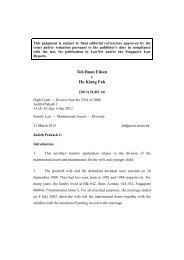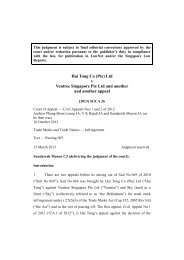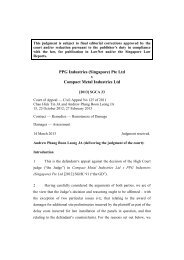Tian Shaokai v Tiong Hwa Steel Sructures Pte Ltd
Tian Shaokai v Tiong Hwa Steel Sructures Pte Ltd
Tian Shaokai v Tiong Hwa Steel Sructures Pte Ltd
Create successful ePaper yourself
Turn your PDF publications into a flip-book with our unique Google optimized e-Paper software.
This judgment is subject to final editorial corrections approved by the<br />
court and/or redaction pursuant to the publisher’s duty in compliance<br />
with the law, for publication in LawNet and/or the Singapore Law<br />
Reports.<br />
<strong>Tian</strong> <strong>Shaokai</strong><br />
v<br />
<strong>Tiong</strong> <strong>Hwa</strong> <strong>Steel</strong> <strong>Sructures</strong> <strong>Pte</strong> <strong>Ltd</strong><br />
High Court — Suit No 689 of 2011<br />
Tan Teck Ping Karen AR<br />
20, 21 and 22 March; 19 April 2013<br />
Damages — Assessment<br />
[2013] SGHCR 13<br />
13 May 2013 Judgment reserved.<br />
Tan Teck Ping Karen AR:<br />
Introduction<br />
1 The defendant is a Singapore company engaged in, inter alia, the<br />
business of manufacture of steel structures, tables and chairs and related<br />
products, equipment rental and leasing services. The plaintiff, <strong>Tian</strong> <strong>Shaokai</strong>, is<br />
a Chinese national who was employed by the defendant as a driver. The<br />
plaintiff arrived in Singapore on 4 July 2010. Shortly after his arrival, the<br />
plaintiff was involved in an accident on 11 August 2010 and now claims for<br />
damages arising from the injuries suffered from this accident.
<strong>Tian</strong> <strong>Shaokai</strong> v <strong>Tiong</strong> <strong>Hwa</strong> <strong>Steel</strong> Structures <strong>Pte</strong> <strong>Ltd</strong> [2013] SGHCR 13<br />
Background facts<br />
2 The plaintiff was born on 27 September 1987. At the time of the<br />
accident, he was 22 years old. At the time of the assessment, he was 25 years<br />
old.<br />
3 The plaintiff worked as a truck driver in China before coming to<br />
Singapore on 4 July 2010. The plaintiff’s evidence is that he planned to work<br />
in Singapore for as long as he could to provide for his family.<br />
4 The plaintiff suffered injuries from the accident on 11 August 2010<br />
and was on medical leave from 11 August 2010 to 16 December 2010 and<br />
from 11 January 2011 to 11 March 2011. He was on light duties from 17<br />
December 2010 to 10 January 2011.<br />
5 The plaintiff’s evidence is that after the period of his medical leave, he<br />
returned to work and was assigned the job of cutting strings and stacking table<br />
cloth. The plaintiff’s work permit was subsequently terminated and he<br />
returned to China on 4 May 2011.<br />
6 After his return to China, the plaintiff says that he was not able to find<br />
employment as a driver or any other labour intensive jobs as he continued to<br />
experience pain and stiffness in both ankles. The plaintiff eventually found a<br />
job as a kitchen helper in a small eatery and started work from 1 November<br />
2012.<br />
Agreed items<br />
7 The parties have agreed on the following items:<br />
2
<strong>Tian</strong> <strong>Shaokai</strong> v <strong>Tiong</strong> <strong>Hwa</strong> <strong>Steel</strong> Structures <strong>Pte</strong> <strong>Ltd</strong> [2013] SGHCR 13<br />
(a) General damages for closed fracture of left medial malleolus of<br />
tibia, fracture of left talar neck with subluxation (dislocation) of the<br />
subtalar joint (left ankle); and<br />
(b) Special damages for transport and medical expenses in<br />
Singapore.<br />
8 I now move on to the items in dispute.<br />
General Damages<br />
Open fracture right distal tibia and fibula fracture (right leg)<br />
9 Dr Tang Zhi Hao (“Dr Tang”) a medical officer of the Department of<br />
orthopaedic surgery of Khoo Teck Puat Hospital had attended to the plaintiff<br />
from the time of the accident till the time the plaintiff returned to China in<br />
May 2010. He stated in his medical report dated 1 April 2011 that the plaintiff<br />
“underwent wound debridement of right lower leg, open reduction and internal<br />
fixation of the right tibia...on 12 August 2010” and that on follow up, it was<br />
observed that the “fractures were healing well and he was put on partial<br />
weight bearing with clutches’.<br />
10 Dr S R E Sayampanathan (“Dr Nathan”), an orthopaedic surgeon,<br />
examined the plaintiff on 22 March 2011. Dr Nathan confirmed in his medical<br />
report dated 22 March 2011 that, from x-rays of the right tibia and fibula done<br />
on 11 January 2011, the fracture had callus (new bone formation) and was<br />
uniting. Dr Nathan noted that the movement of the right ankle was decreased<br />
and that the plaintiff complained of pain, weakness and stiffness in both<br />
ankles.<br />
3
<strong>Tian</strong> <strong>Shaokai</strong> v <strong>Tiong</strong> <strong>Hwa</strong> <strong>Steel</strong> Structures <strong>Pte</strong> <strong>Ltd</strong> [2013] SGHCR 13<br />
11 The plaintiff was also reviewed by Dr Wong Yue Shuen (“Dr Wong”),<br />
a specialist orthopaedic surgeon, on 15 May 2012. In his report dated 24 May<br />
2012, Dr Wong stated that he had ordered new x-rays and the x-rays showed<br />
“on the right lower limb, a healed fracture of the right tibia and fibula”. Dr<br />
Wong was of the opinion that the fractures in the right distal tibia and fibula<br />
have fully healed. However, the clinical range of motion on both lower limbs<br />
was “markedly limited”.<br />
12 The medical evidence from all the doctors are that the fracture of the<br />
right tibia and fibula is fully healed with decreased movement in the right<br />
ankle. There also appears to be some residual pain and stiffness as reported by<br />
the plaintiff.<br />
13 The plaintiff claims the amount of $25,000 for this item based on the<br />
case of Goh Eng Hong v Management Corporation of Textile Center and<br />
another (“Goh Eng Hong”) [2003] 1 SLR(R) 209. In this case, a 51 year old<br />
host mamasan suffered an open compound fracture of the left tibia and fibula.<br />
There was a delayed union of the fractured left tibia which required<br />
posterolateral bone grafting and x-rays showed poor fracture union. Acute<br />
shortening and Ilizarov distraction osteotomy of the left tibia and limited bone<br />
grafting were conducted. The plaintiff had to wear a shoe with a shoe raise and<br />
walked with a mild limp. She was awarded $40,000 for the fracture of the left<br />
tibia and fibula as well as the fracture of the medial malleolus of left ankle.<br />
14 I am of the view that Goh Eng Hong may be distinguished as injuries<br />
and disabilities suffered by the plaintiff were significantly more severe than<br />
this case.<br />
4
<strong>Tian</strong> <strong>Shaokai</strong> v <strong>Tiong</strong> <strong>Hwa</strong> <strong>Steel</strong> Structures <strong>Pte</strong> <strong>Ltd</strong> [2013] SGHCR 13<br />
15 In Koh Lu Kuang v Abdul Jalil bin Kader Hussein (“Koh Lu Kuang”)<br />
DC Suit No 4293 of 1998, the amount of $14,000 was awarded for fracture of<br />
the left tibia and fibula which was treated by open reduction and internal<br />
fixation for fracture to tibia and fibula.<br />
16 I am of the view that the amount awarded in Koh Lu Kuang is more in<br />
line with the injury suffered by the plaintiff in this case and award the sum of<br />
$14,000 for this item.<br />
Osteoarthritis of left ankle<br />
17 Dr Nathan in his medical report dated 22 March 2011 was of the view<br />
that “the left ankle injury was an intra-articular injury. As such, [the plaintiff]<br />
would be expected to develop post-traumatic osteo-arthritis of the left ankle”.<br />
18 Dr Wong stated in his medical report dated 24 May 2012 that the<br />
plaintiff “has no obvious evidence of arthritis on his x rays. However, the left<br />
sided injuries in particular may develop arthritis in both the ankle and<br />
subtalar joints, as the fractures have involved these joints”.<br />
19 I agree with the defendant’s submission that there has been no<br />
manifestation of osteoarthritis yet and there is no certainty that the plaintiff<br />
would indeed develop osteoarthritis. Since the plaintiff only has a predisposition<br />
to developing osteoarthritis of his left ankle, I accept the<br />
defendant’s submission that the sum of $3,000, based on Tan Swee Khoon v<br />
Balu a/l Sinnathamby DC Suit No 225 of 1998, is a fair amount to be award<br />
for this item.<br />
5
<strong>Tian</strong> <strong>Shaokai</strong> v <strong>Tiong</strong> <strong>Hwa</strong> <strong>Steel</strong> Structures <strong>Pte</strong> <strong>Ltd</strong> [2013] SGHCR 13<br />
Scars<br />
20 The plaintiff has various scars arising from the injuries as follows:<br />
(a) 18.5 cm scar over medial aspect of right ankle;<br />
(b) 8 cm scar over medial aspect of left ankle; and<br />
(c) Two separate scars of 1 cm over dorsum of the left ankle.<br />
21 The plaintiff submits that $10,000 should be awarded for the scars<br />
based on the range provided for multiple scars which is between $5,000 to<br />
$15,000 at page 57 of the Guidelines for the Assessment of General Damages<br />
in Personal Injury Cases (Academy Publishing, 2010).<br />
22 The defendant relies on Aw Ang Moh v OCWS Logistics <strong>Pte</strong> <strong>Ltd</strong> [1998]<br />
SGHC 167 where the amount of $4,000 was awarded for 2 scars from skin<br />
grafts measuring 9 cm x 8cm and 7cm x 2cm, a 3 cm surgical scar, 10 cm<br />
laceration scar and 4cm x 2 cm abrasion scar. The defendant submits the<br />
amount of $3,000 as the scars in this case as the scars on this authority is more<br />
severe than that of the plaintiff here. I agree with the defendant’s submission<br />
as the authority relied on provides details of the scars that were suffered and<br />
accordingly award $3,000 for this item.<br />
Loss of Future Earnings v Loss of Earning Capacity<br />
23 The issue is whether loss of future earnings, as submitted by the<br />
plaintiff, or loss of earning capacity, as submitted by the defendant, should be<br />
made.<br />
24 In Teo Sing Keng & Anor v Sim Ban Kiat [1994] 1 SLR 634 (“Teo<br />
Sing Keng”), the Court of Appeal stated at p646:<br />
6
<strong>Tian</strong> <strong>Shaokai</strong> v <strong>Tiong</strong> <strong>Hwa</strong> <strong>Steel</strong> Structures <strong>Pte</strong> <strong>Ltd</strong> [2013] SGHCR 13<br />
Although loss of earnings and loss of earning capacity have<br />
sometimes been used interchangeably, they are separate<br />
heads of damage. Lord Denning MR in Fairley v John<br />
Thompson (Design & Contracting Division) <strong>Ltd</strong> at p42 alluded to<br />
this difference:<br />
It is important to realise that there is a difference<br />
between an award for loss of earnings as distinct from<br />
compensation for loss of earning capacity.<br />
Compensation for loss of future earnings is awarded<br />
for real assessable loss proved by evidence.<br />
Compensation for diminution in earning capacity is<br />
awarded as part of general damages.<br />
The above passage was quoted with approval by Browne LJ in<br />
the leading English case on loss of earning capacity, Moeliker v<br />
A Reyrolle & Co <strong>Ltd</strong> at p 15, where the learning judge said:<br />
...<br />
This court made it clear in Robert v Heavy Transport<br />
(EEC) <strong>Ltd</strong> and Herod v Birds Eye Foods that Smith v<br />
Manchester Corp laid down no new principle of law,<br />
and I entirely agree. Smith v Manchester Corp is merely<br />
an example of an award of damage under a head which<br />
has long been recognized – a plaintiff’s loss of earning<br />
capacity where, as a result of his injury, his chances in<br />
the future of getting in the labour market work (or<br />
work as well paid as before the accident) have been<br />
diminished by his injury. This court made an award<br />
under this heard in Ashcroft v Curtin three years before<br />
Smith v Manchester Corp. This head of damage<br />
generally arises where a plaintiff is, at the time of the<br />
trial, in employment, but there is a risk that he may<br />
loss this employment at some time in the future and<br />
may then, as a result of his injury, be at a<br />
disadvantage in getting another job or an equally well<br />
paid job. It is a different head of damages from an<br />
actual loss of future earnings which can be proved at<br />
the time of trial.<br />
An award for loss of earning capacity, as opposed to an award<br />
for loss of earnings, is generally made in the following cases:<br />
(1) where, at the time of trial, the plaintiff is in<br />
employment and has suffered no loss of earnings, but<br />
there is a risk that he may lose that employment at<br />
some time in the future, and may then, as a result of<br />
his injury, be at a disadvantage in getting another job<br />
or any equally well-paid job;<br />
7
<strong>Tian</strong> <strong>Shaokai</strong> v <strong>Tiong</strong> <strong>Hwa</strong> <strong>Steel</strong> Structures <strong>Pte</strong> <strong>Ltd</strong> [2013] SGHCR 13<br />
(2) where there is no available evidence of the<br />
plaintiff’s earnings to enable the court to properly<br />
calculate future earnings, for example young children<br />
who have no earnings on which to base an assessment<br />
for loss of future earnings.<br />
25 In Liu Haixiang v China Construction (South Pacific) Development Co<br />
<strong>Pte</strong> <strong>Ltd</strong> [2009] SGHC 21(“Liu Haixiang”), Prakash J referred to the above<br />
quote from Teo Sing Keng and observed at [25]:<br />
It can be seen from the above discussion that where there is a<br />
measurable loss of earnings, the correct award is for loss of<br />
future earnings. In this case, there was a measurable loss of<br />
earnings because, due to his injury, the plaintiff was no longer<br />
able to work as a construction in Singapore and at the time of<br />
the trial he was, in fact, no longer in such employment.<br />
26 Prakash J emphasised at [27] that:<br />
It would be recalled that in Teo Sing Keng, the court of Appeal<br />
opined that a loss of earning capacity award would also be<br />
appropriate where there was no available evidence of the<br />
plaintiff’s earnings to enable the Court to properly calculate<br />
future earnings. This was not the case here. The<br />
documentation established what the plaintiff earned during<br />
his stay in Singapore. The plaintiff also gave evidence of what<br />
he earned in China prior to coming to Singapore and that<br />
evidence was not challenged. Whilst there may be some gaps<br />
in the evidence relating to the possible salary that the plaintiff<br />
might achieve in the future, such gaps mean that the<br />
calculation of the plaintiff’s damages might lead to a lower<br />
figure than the plaintiff would like but those gaps do not make<br />
it impossible to derive an award on the basis of loss of future<br />
earnings. The evidence in this case supports the plaintiff’s<br />
claim that the proper award would be future earnings.<br />
27 In this case, following Liu Haixiang, I similarly find that there is a<br />
measurable loss of earnings because, due to his injury, the plaintiff was no<br />
longer able to work as a driver in Singapore and at the time of the assessment<br />
of damages, he was, in fact, no longer in such an employment. Dr Nathan<br />
stated in his medical report that he was of the view that the plaintiff would not<br />
be able to take up a vocation such as a driver due to the disabilities in his<br />
8
<strong>Tian</strong> <strong>Shaokai</strong> v <strong>Tiong</strong> <strong>Hwa</strong> <strong>Steel</strong> Structures <strong>Pte</strong> <strong>Ltd</strong> [2013] SGHCR 13<br />
ankles. This was affirmed when he gave evidence in court. Dr Wong stated in<br />
his medical report dated 20 September 2012 that he was of the opinion that the<br />
plaintiff may be able to drive a vehicle but he clarified when he gave evidence<br />
in court that his opinion in the said report was in relation to whether the<br />
plaintiff can drive a taxi or a normal car. Dr Wong went on to clarify that the<br />
plaintiff will find it hard to drive a heavy goods vehicle and climbing in and<br />
out of such a vehicle will pose difficulties for him.<br />
28 The plaintiff was injured just over a month after his arrival in<br />
Singapore but there are the pay slips and the insurance claim form to establish<br />
what the plaintiff earned during the short time he worked before the accident<br />
and to calculate what he would have earned but for the accident.<br />
29 The plaintiff has also provided evidence that, prior to coming to<br />
Singapore, he worked as a truck driver in China earning approximately $800<br />
per month and has produced a Certificate of Income from his ex-employer in<br />
China. The defendant has challenged this evidence on basis that the plaintiff<br />
has failed to call his ex-employers from China to corroborate this evidence.<br />
However, the fact remains that this document has been produced and the<br />
defendant has not produced any documentary evidence to contradict this. Even<br />
if this evidence has not been corroborated, this might mean that the calculation<br />
of the plaintiff’s damages might lead to a lower figure but this does not make<br />
it impossible to derive an award on the basis of loss of future earnings. See<br />
Prakash J in Liu Haixiang at [27].<br />
30 Therefore, I am of the view that there is sufficient evidence in this case<br />
to calculate the plaintiff’s loss of earning and to award loss of future earnings.<br />
9
<strong>Tian</strong> <strong>Shaokai</strong> v <strong>Tiong</strong> <strong>Hwa</strong> <strong>Steel</strong> Structures <strong>Pte</strong> <strong>Ltd</strong> [2013] SGHCR 13<br />
Loss of Future Earnings<br />
31 The first issue to be determined is the appropriate multiplier.<br />
32 The plaintiff was 22 years old at the time of the accident and presently,<br />
he is 25 years old. I am of the view that a multiplier of 18 would be<br />
appropriate and are in line with the following cases:<br />
(a) In Teo Seng Kiat v Goh <strong>Hwa</strong> Teck [2003] 1 SLR 333 (cited in<br />
the Practitioner’s Library - Assessment of Damages: Personal Injuries<br />
and Fatal Accidents (Lexis Nexis, 2 nd Ed, 2005 (“Practitioner’s<br />
Library”) at p657), a multiplier of 18 years was applied in respect of<br />
the plaintiff, a male, who was injured at the age of 25.<br />
(b) In Wu Liang Zhu v Chan Yue Ming & Anor [2002] SGHC 91<br />
(cited in the Practitioner’s Library at p676), a multiplier of 17 years<br />
was applied in respect of the plaintiff, a male, who was injured at the<br />
age of 28.<br />
33 As the plaintiff is a foreigner working in the manufacturing industry,<br />
which is similar to the construction industry, I am of the view that the<br />
Singapore portion should be awarded 8 years and the China portion should be<br />
awarded 10 years. This would “more accurately reflect the vicissitudes of life<br />
and particularly of working life for a foreigner in the construction industry<br />
who needs a work permit and has to complete for jobs with younger foreign<br />
workers”. See Liu Haixiang at [31].<br />
34 The second issue is to determine the multiplicand. In calculating this, I<br />
follow the method laid down by Prakash J in Liu Haixiang at [33].<br />
10
<strong>Tian</strong> <strong>Shaokai</strong> v <strong>Tiong</strong> <strong>Hwa</strong> <strong>Steel</strong> Structures <strong>Pte</strong> <strong>Ltd</strong> [2013] SGHCR 13<br />
35 In line with the High Court in Liu Haixiang and the Court of Appeal in<br />
Poh Huat Heng Corp <strong>Pte</strong> <strong>Ltd</strong> and others v Hafizul Islam Kofil Uddin [2012] 3<br />
SLR 1003 (“Poh Huat Heng”), I am of the view that a split multiplicand<br />
should be adopted with part of the multiplicand calculated on the basis of the<br />
plaintiff’s wages in Singapore and the other part on his possible wages in<br />
China.<br />
36 First, I determine what the plaintiff would be able to earn in China in<br />
his present condition. As mentioned above, the plaintiff has produced a<br />
Certificate of Income from his ex-employer in China stating that he earned<br />
$800 per month as a driver. The defendant has challenged this evidence on the<br />
basis that it has not been corroborated as the plaintiff has not called his ex-<br />
employer to give evidence on the same.<br />
37 In Wee Sia <strong>Tian</strong> v Long Thik Boon [1996) 2 SLR(R) 420 (“Wee Sia<br />
<strong>Tian</strong>”) at [12] and [15], the plaintiff produced documentary evidence that<br />
showed his salary before the accident as $677 a month. No evidence was<br />
called to contradict the employer’s letter or the attached income tax forms.<br />
Neither did any one from the plaintiff’s present employer testify. The court<br />
was of the view that in the absence of any evidence contradicting the<br />
documentary evidence before the court, the plaintiff had only been able to<br />
establish that he earned $677 a month before the accident.<br />
38 The decision of the court in Wee Sia <strong>Tian</strong> above will apply in relation<br />
to the Certificate of Income that has been produced by the plaintiff as proof of<br />
his income prior to the accident. As there is no contradictory evidence before<br />
the court, the plaintiff has established that he earned $800 before the accident.<br />
11
<strong>Tian</strong> <strong>Shaokai</strong> v <strong>Tiong</strong> <strong>Hwa</strong> <strong>Steel</strong> Structures <strong>Pte</strong> <strong>Ltd</strong> [2013] SGHCR 13<br />
39 Both Dr Nathan and Dr Wong have given evidence that the plaintiff<br />
cannot return to driving a lorry. Dr Wong has expressed the opinion that the<br />
plaintiff can still drive a normal car or a taxi. This would mean that<br />
employment as a chauffeur or a taxi driver is still an option for the plaintiff.<br />
There is no evidence on what the plaintiff would earn as a chauffeur or taxi<br />
driver in China. The only evidence before the court is that the salary of a lorry<br />
driver is $800 a month. I am of the view that the salary of a chauffeur or taxi<br />
driver should at the minimum be equal to that of a lorry driver and so take the<br />
figure of $800 a month as the amount the plaintiff can earn in his present<br />
condition in China. I then deduct the amount of $200 that the plaintiff is<br />
present earning as a kitchen assistant, from the notional salary of $800.<br />
40 As for the Singapore portion for the loss of earnings, I used the amount<br />
of $1,029.29 that was declared by the defendant as the plaintiff’s gross<br />
monthly earnings for July 2010 in the Work Injury Compensation Insurance<br />
Claim form submitted by the defendant. Firstly, this is a document prepared by<br />
the defendant and Ms Kan Phui Chun (“Ms Kan”), the defendant’s<br />
representative, confirmed under cross examination, that the plaintiff’s gross<br />
monthly earning which is stated in this document as $1,029.29 is not disputed.<br />
Secondly, while the evidence is that the plaintiff’s monthly basic salary is<br />
$700, Ms Kan admitted that the plaintiff would be guaranteed overtime if he<br />
worked for the defendants. For these reasons, I am of the view that the sum of<br />
$1,029.29 is the appropriate figure to calculate the Singapore portion for the<br />
loss of earnings. I then deduct the sum of $800, which is the notional amount<br />
the plaintiff would earn in China, from $1,029.29.<br />
41 Therefore, the award for loss of future earnings, is:<br />
(a) Singapore : ($1,029.29 - $800) x 8 years = $22,011.84<br />
12
<strong>Tian</strong> <strong>Shaokai</strong> v <strong>Tiong</strong> <strong>Hwa</strong> <strong>Steel</strong> Structures <strong>Pte</strong> <strong>Ltd</strong> [2013] SGHCR 13<br />
(b) China: ($800 - $200) x 10 years = $72,000<br />
The total award would be $94,011.84.<br />
42 There is one final point I wish to address before I leave this item. The<br />
plaintiff is employed as an unskilled worker and the defendant has argued that<br />
with the recent changes in the increase levy for unskilled worker, it is more<br />
probable that the plaintiff’s work permit, will not be renewed by the defendant<br />
and therefore, the defendant could not continue to work in Singapore after the<br />
expiry of this current work permit. In my view this is pure speculation. While<br />
Ms Kan has testified that given the change in rules, the defendant is likely to<br />
employ skilled rather than unskilled workers, I am of the view that not much<br />
weight should be placed on this. This is because Ms Kan earlier admitted that,<br />
while she was aware of the change in rules, she was not very familiar with the<br />
same and so it cannot be inferred that the defendant has made a definitive<br />
decision to employ skilled workers only and will not continue to employ the<br />
plaintiff when his permit expires. This is especially since the amount of<br />
increase is not prohibitive (the levy is currently $300 and will be $350 in July<br />
2013, $370 in 2014 and $400 in 2015) and there is nothing to suggest that the<br />
defendant will not continue to employ the plaintiff despite the increase in levy.<br />
Future medical care<br />
43 The Court of Appeal in Poh Huat Heng observed at [64] that when the<br />
plaintiff is a foreign national and has returned to his home country and is<br />
receiving medical treatment there, it follows “as a matter of logic and common<br />
sense that the cost of medical care in his home country should be the basis<br />
upon which to calculate the multiplicand to be used in determining the amount<br />
to be awarded for future medical expenses”.<br />
13
<strong>Tian</strong> <strong>Shaokai</strong> v <strong>Tiong</strong> <strong>Hwa</strong> <strong>Steel</strong> Structures <strong>Pte</strong> <strong>Ltd</strong> [2013] SGHCR 13<br />
44 The plaintiff has provided a Certificate of Diagnosis Dezhou<br />
Municipal Hospital by Dr Wan Lingmin (“Dr Wan”) providing the costs for<br />
the removal of metal implants, surgery for arthritis, medial reviews and<br />
physiotherapy.<br />
45 Despite the fact that the defendant was fully aware that the plaintiff<br />
was seeking an award for future medical care and that an award for this should<br />
be based on the costs of medical care in China, the defendant only raised this<br />
issue during submissions with the defendant urging the court to disregard Dr<br />
Wan’s certificate as Dr Wan has not been called to give evidence and to award<br />
$5,000 for costs of future medical treatment. In light of this, no evidence was<br />
led from the Singapore doctors on their views on whether the medical<br />
expenses stated in Dr Wan’s certificate were reasonable.<br />
46 As stated above, the court will not disregard documentary evidence<br />
simply because it has not been corroborated especially since the defendant has<br />
not produced any evidence to the contrary. Therefore, Dr Wan’s certificate<br />
will be taken into consideration when assessing the amount to be awarded for<br />
future medical care in China.<br />
47 Both Dr Nathan and Dr Wong agree that an operation should be carried<br />
out to remove the implants in both lower limbs. Dr Nathan gives the figure of<br />
$8,000 while Dr Wong gives the figure of between $8,000 to $11,000. Dr<br />
Wan’s Certificate states that the costs of this surgery in China is $8,000.<br />
Accordingly, I award $8,000 for the removal of metal implants.<br />
48 Both Dr Nathan and Dr Wong opined that the plaintiff did not have<br />
arthritis at present but was at risk of developing it at a future date and surgery<br />
will be required to fuse the ankle. Dr Nathan gives the figure of $22,000 while<br />
14
<strong>Tian</strong> <strong>Shaokai</strong> v <strong>Tiong</strong> <strong>Hwa</strong> <strong>Steel</strong> Structures <strong>Pte</strong> <strong>Ltd</strong> [2013] SGHCR 13<br />
Dr Wong gives the figure of $14,000 to $30,000. Dr Wan gives the figure of<br />
$24,000. Since arthritis is only a potential risk, I award the sum of $5,000 for<br />
this item.<br />
49 Dr Nathan also recommends medical reviews. Dr Wong does not<br />
mention this. There is also no estimate of costs in Dr Wan’s Certificate for this<br />
item. However, I acknowledge that there will be some pre and post operation<br />
review for the removal of metal implants and I am of the view that $200 will<br />
be a fair amount for this review and award this sum.<br />
50 Dr Nathan recommends physiotherapy. Dr Wong is silent on this item.<br />
Therefore, no award is made for this item as it does not appear to be a<br />
treatment that is necessary.<br />
51 Therefore, the total amount awarded for future medical treatment is<br />
$13,200.<br />
Special Damages<br />
Pre-trial medical expenses in China<br />
52 The plaintiff claims $11,400.40 for this item and has produced receipts<br />
and documents in support of the same. It is trite law that special damages have<br />
to be strictly proven, otherwise they are not recoverable. See Wee Sia <strong>Tian</strong>.<br />
53 The defendant submits that it is unclear from the receipts what these<br />
payments for. I agree. While the receipts state that it is for payment of<br />
treatment, the treatment is not specified and it is unclear whether the treatment<br />
received is related to the injuries suffered by the plaintiff arising from the<br />
accident in Singapore. Therefore, no award is made for this item.<br />
15
<strong>Tian</strong> <strong>Shaokai</strong> v <strong>Tiong</strong> <strong>Hwa</strong> <strong>Steel</strong> Structures <strong>Pte</strong> <strong>Ltd</strong> [2013] SGHCR 13<br />
Pre-trial loss of earnings<br />
54 Pre-trial loss of earnings is separated into the following time frames for<br />
consideration:<br />
(a) From the date of accident (11 August 2010) to date plaintiff<br />
returned to China (4 May 2011);<br />
(b) From the date of return to China (5 May 2011) to expiry of the<br />
work permit (24 June 2012)<br />
(c) From after expiry of the work permit (25 June 2012) to before<br />
commencement of new job (30 October 2012)<br />
(d) From commencement of new job (1 November 2012) to 7<br />
February 2013.<br />
From the date of accident (11 August 2010) to date plaintiff returned to China<br />
(4 May 2011)<br />
55 This period is divided into two sub-periods. The first period of 11<br />
August 2010 to 11 March 2011 is when the plaintiff was on medical leave and<br />
light duties. The second period is from the expiry of the medical leave and<br />
light duty on 12 March 2011 to the plaintiff’s return to China on 4 May 2011.<br />
(a) Medical leave and light duty from 11 August 2010 to 11 March 2011<br />
56 The plaintiff was on medical leave from 11 August 2010 to 16<br />
December 2010 and from 11 January 2011 to 11 March 2011. The In-principle<br />
approval for work permit issued to the defendant in respect of the plaintiff<br />
states the plaintiff’s basic salary as $700. The plaintiff also admitted during<br />
16
<strong>Tian</strong> <strong>Shaokai</strong> v <strong>Tiong</strong> <strong>Hwa</strong> <strong>Steel</strong> Structures <strong>Pte</strong> <strong>Ltd</strong> [2013] SGHCR 13<br />
cross examination that this was his basis salary. Therefore, the amount the<br />
plaintiff is to be paid when on medical leave is $700 a month.<br />
57 The plaintiff was on light duty from 17 December 2010 to 10 January<br />
2011. During this period, the evidence is that the defendant prescribed the<br />
plaintiff the jobs of folding table clothes, cleaning the area in the workshop<br />
and shredding papers in the office (“Light Duty jobs”).<br />
58 Since the plaintiff was medically certified to be only fit to do light duty<br />
during this period, it would follow that the plaintiff was similarly entitled to<br />
his basic salary of $700 during this period. A perusal of the plaintiff’s payslips<br />
for this period show that the plaintiff was paid a lower salary during this<br />
period. When queried on the pay slip for December 2010 during cross<br />
examination, Ms Kan explained that a lower amount was paid because the<br />
plaintiff “did not work for the whole month and we pay what he clocked in”.<br />
This was the first mention of the fact that the plaintiff was expected to clock in<br />
during the period he was on light duty and I note that none of the time sheets<br />
for this period have been produced in evidence. In the absence of such<br />
evidence, the assertion that the plaintiff was paid for the hours he worked<br />
when on light during is nothing more than a bare assertion. Accordingly, I find<br />
that the plaintiff is entitled to his basic salary of $700 during the period he was<br />
on light duty.<br />
59 Therefore, the plaintiff is entitled to his basic salary of $700 per month<br />
for the period of 11 August 2010 to 11 March 2011 when he was on medical<br />
leave and certified to be on light duty. This amounts to $4,922.60.<br />
17
<strong>Tian</strong> <strong>Shaokai</strong> v <strong>Tiong</strong> <strong>Hwa</strong> <strong>Steel</strong> Structures <strong>Pte</strong> <strong>Ltd</strong> [2013] SGHCR 13<br />
(b) From the expiry of medical leave and light duty to the return to China: 12<br />
March 2011 to 4 May 2011<br />
60 The plaintiff ceased to be on light duty from 12 March 2011. However,<br />
the defendant continued to assign the plaintiff the Light Duty jobs even though<br />
he was fit to return to work.<br />
61 The plaintiff’s evidence is that he was not informed by the defendant<br />
that it would be happy to continue to employ him after he returned from<br />
medical leave. His evidence is that it was the defendant who informed him that<br />
it was cancelling his work permit. He denies that he was the one who informed<br />
the defendant that he did not wish to continue working for them.<br />
62 In her affidavit of evidence in chief, Ms Kan stated that the plaintiff<br />
“was managing to carry out his tasks very well and [she] was happy that he<br />
was managing his task very well”. It was further stated that the defendant<br />
“would have been in a position to continue to engage the plaintiff to carry out<br />
[the Light Duty jobs] up to the end of his work permit and might even have<br />
extended his work person if the plaintiff continued to carry out his task<br />
properly”. However, during cross examination, Ms Kan gave a different story.<br />
Ms Kan stated that it was not the defendant’s intention to assign the plaintiff<br />
the jobs he was doing when on light duty on a long term basis and that the<br />
plaintiff could go out with his disabilities and perform his job as a tent erector<br />
by assisting on the ground and he will get his basic salary and overtime. The<br />
evidence is that though the plaintiff had been employed as a driver, he has not<br />
obtained a Singapore driving licence and so was being trained as a tent erector<br />
pending the next driving test.<br />
63 Ms Kan acknowledged that the plaintiff had requested to return to<br />
work on the field but the defendant did not allow him to do so. Ms Kan said<br />
18
<strong>Tian</strong> <strong>Shaokai</strong> v <strong>Tiong</strong> <strong>Hwa</strong> <strong>Steel</strong> Structures <strong>Pte</strong> <strong>Ltd</strong> [2013] SGHCR 13<br />
that the reason for this was that the defendant was of the view that the plaintiff<br />
had not fully recovered and so, out of goodwill, it continued to assign him the<br />
Light Duty jobs. Ms Kan further admitted that the reason the plaintiff was kept<br />
on Light Duty jobs was that the defendant wanted to keep the plaintiff around<br />
while he pursued his workmen compensation claim with the Ministry of<br />
Manpower. It was admitted that the reason the plaintiff’s work permit was<br />
subsequently terminated was that the plaintiff had decided to withdraw the<br />
workmen compensation claim and to pursue his claim under the common law.<br />
64 The plaintiff’s and the defendant’s version of the reason the plaintiff<br />
returned to China is at polar opposites. The plaintiff says that it was the<br />
defendant who told him that the work permit will be terminated. The<br />
defendant says that it was the plaintiff who called and said that he did not wish<br />
to work further for the defendant.<br />
65 From my observation of the plaintiff and Ms Kan, I am of the view that<br />
they are both not credible witnesses. The plaintiff gave evidence that he<br />
required clutches to move around up to the time he returned to China.<br />
However, Ms Toh Chuee Hin, an employee of the defendant, gave evidence of<br />
meeting the plaintiff on the bus after work and learning that the plaintiff was<br />
going to Little India to meet friends. The plaintiff was not using clutches on<br />
this trip. The plaintiff’s explanation for this was that he was training himself to<br />
move around without clutches and had to take rest frequently during this trip.<br />
The plaintiff was also observed by Ms Kan to move around the defendant’s<br />
premises without clutches when he thought that he was not observed.<br />
66 Ms Kan’s evidence is also contradictory. In her affidavit of evidence in<br />
chief she states that the plaintiff was managing the task she had assigned him<br />
to do while on light duty very well and she was happy that he was managing<br />
19
<strong>Tian</strong> <strong>Shaokai</strong> v <strong>Tiong</strong> <strong>Hwa</strong> <strong>Steel</strong> Structures <strong>Pte</strong> <strong>Ltd</strong> [2013] SGHCR 13<br />
the task well. However, during cross examination, Ms Kan described the<br />
plaintiff as “being a bit slack” and that “he would be lazy doing” the jobs that<br />
he was assigned when he was on light duty. She also gave different evidence<br />
on what jobs the plaintiff would be assigned to do if he were to stay to work<br />
with the defendant.<br />
67 Though the plaintiff and Ms Kan both appear to be unreliable<br />
witnesses, I prefer the plaintiff’s version of events because the plaintiff came<br />
to Singapore to work and support his family. There is no incentive for him to<br />
voluntarily quit and return to China where the prospect of obtaining<br />
employment with his injuries is uncertain. Second, the plaintiff’s work permit<br />
was terminated just after the plaintiff decided to withdraw the workmen<br />
compensation claim and to commence the common law claim. The timing<br />
appears to support the plaintiff’s position that it was the defendant who<br />
terminated his employment. Third, though Ms Kan says initially that she was<br />
happy with plaintiff’s work, a different picture emerged during cross<br />
examination where Ms Kan said that plaintiff was lazy and did not want to<br />
work. Bearing all this in mind, I am of the view that it is more probable that it<br />
was the defendant who terminated the plaintiff’s work permit on hearing that<br />
plaintiff had decided to commence the common law claim.<br />
68 Even if it is true that it was the plaintiff who informed the defendant<br />
that he did not wish to continue working for the defendant, I am of the view<br />
that the plaintiff was forced to do so due to the work assignments and pay he<br />
received when on light duty and then subsequently after his medical leave had<br />
expired. The evidence from Ms Kan is that, though the plaintiff had requested<br />
to return to work in the field and earn his basic salary with overtime after the<br />
expiry of his medical leave and light duty, it was the defendant who had<br />
decided not to send him out but had kept him in the office to continue with his<br />
20
<strong>Tian</strong> <strong>Shaokai</strong> v <strong>Tiong</strong> <strong>Hwa</strong> <strong>Steel</strong> Structures <strong>Pte</strong> <strong>Ltd</strong> [2013] SGHCR 13<br />
light duty task at a drastically reduced salary. The initial evidence from the<br />
defendant was that it intended to continue to employ the plaintiff in this<br />
capacity and at this reduced pay till the end of his work permit. However, the<br />
plaintiff was not informed of this. It was later clarified during the assessment<br />
of damages that the plaintiff would be allowed out to the field and would earn<br />
his basic salary with overtime. However, it appears that none of this was told<br />
to the plaintiff prior to his return to China. Therefore, I am of the view that,<br />
even if the plaintiff was the person who had indicated that he did not wish to<br />
continue working for the defendant, the defendant had created a working<br />
environment that so unfavourable that the plaintiff was justified in doing so.<br />
69 Since the evidence is that the plaintiff could have returned to the field<br />
to work and earn his basic salary and overtime after his medical leave and<br />
light duty leave had ceased, I am of the view that he should be awarded the<br />
sum of $1,029.29 per month for the period of 12 March 2011 to 4 May 2011.<br />
This amounts to $1,792.89.<br />
From the date of return to China (5 May 2011) to expiry of the work permit<br />
(24 June 2012)<br />
70 In light of my decision that it was the defendant who had terminated<br />
the work permit or alternatively, that the plaintiff was justified in terminating<br />
his employment with the defendant, it would follow that the plaintiff should be<br />
paid the salary he had earned if he had return to normal duties.<br />
71 However, the plaintiff is under a duty to mitigate his loss by looking<br />
for alternative employment. Bearing in mind that the plaintiff was still<br />
recovering from his injuries and had just returned to China, I am of the view<br />
that it would reasonable to allow him four months to seek alternative<br />
employment and the plaintiff should have found a job by September 2011.<br />
21
<strong>Tian</strong> <strong>Shaokai</strong> v <strong>Tiong</strong> <strong>Hwa</strong> <strong>Steel</strong> Structures <strong>Pte</strong> <strong>Ltd</strong> [2013] SGHCR 13<br />
72 Therefore, I will award the plaintiff the full amount of $1,029.29 per<br />
month for the four month period from 5 May 2011 to the end of August 2011<br />
spent looking for a job. For the balance of this period, the plaintiff is under a<br />
duty to mitigate his loss by trying to find alternative employment. As there is<br />
no evidence of any attempts to find alternative employment, the plaintiff is not<br />
entitled to any payment for loss of earnings from September 2011 to 24 June<br />
2012.<br />
73 Therefore, I award the sum of $1,029.29 for the period of 6 May 2011<br />
to 30 August 2011. This amounts to $3,917.87.<br />
From after expiry of the work permit (25 June 2012) to before commencement<br />
of new job (30 October 2012)<br />
74 The onus is on the plaintiff to provide evidence that he would have<br />
stayed on in Singapore after the expiry of his work permit. While I am mindful<br />
of the fact that the plaintiff has given evidence that he intended to stay on in<br />
Singapore for as long as possible, the reality is that it would be difficult for the<br />
plaintiff to find employment with another employer with his disabilities. There<br />
is also no evidence of the efforts by plaintiff to find alternative employment<br />
during this period. Therefore, no award is made for this period.<br />
From commencement of new job (1 November 2012) to 7 February 2013<br />
75 The evidence is that the plaintiff has commenced employment as a<br />
kitchen assistant from 1 November 2012 at the salary of $200. I had earlier<br />
found that the plaintiff would be able to work as a chauffeur or taxi driver at<br />
the salary of $800. Therefore, the amount that he would be entitled to for this<br />
period is the difference between $800 and $200.<br />
22
<strong>Tian</strong> <strong>Shaokai</strong> v <strong>Tiong</strong> <strong>Hwa</strong> <strong>Steel</strong> Structures <strong>Pte</strong> <strong>Ltd</strong> [2013] SGHCR 13<br />
76 Accordingly, the award for this period is $600 per month for the period<br />
of 1 November 2012 to 7 February 2013. This amounts to $1,949.80.<br />
77 Therefore, the total amount for pre-trial loss of earning awarded is<br />
$12,583.16.<br />
Conclusion<br />
78 For the reasons stated above, I award the plaintiff the following<br />
amount on a 100% basis:<br />
A General Damages:<br />
(a) Open fracture right distal tibia and<br />
fibula fracture (right leg)<br />
(b) Closed fracture of left medial<br />
malleolus of tibia, fracture of left Talar<br />
neck with subluxation (dislocation) of<br />
the subtalar joint (left ankle)<br />
23<br />
$14,000<br />
(c) Potential osteoarthritis of left ankle $3,000<br />
(d) Scars $3,000<br />
$30,000 (agreed)<br />
(e) Loss of Future Earnings $94,011.84<br />
(f) Future medical expenses $13,200<br />
B Special Damages:<br />
(a) Pre-trial medical expenses (Singapore) $30.50 (agreed)<br />
(b) Pre-trial medical expenses (China) Nil<br />
(c) Transport $100.00 (agreed)<br />
(d) Pre-trial loss of earnings $12,583.16<br />
Less salary received ($5,040.05)
<strong>Tian</strong> <strong>Shaokai</strong> v <strong>Tiong</strong> <strong>Hwa</strong> <strong>Steel</strong> Structures <strong>Pte</strong> <strong>Ltd</strong> [2013] SGHCR 13<br />
24<br />
Sub -total: $7,543.11<br />
TOTAL: $164,885.45<br />
C Interest at half of 5.33% on special damages from the date<br />
of service of the writ to the date of judgment and interest at<br />
5.33% on general damages for pain and suffering from the<br />
date of the service of the writ to the date of judgment.<br />
D Costs on the District Court scale to be agreed or taxed.<br />
79 Interlocutory judgment of 85% was entered in favour of the plaintiff.<br />
Accordingly, the amount awarded to the plaintiff on 85% basis is $140,152.63.<br />
Tan Teck Ping Karen<br />
Assistant Registrar<br />
Mr Eric Liew Hwee Tong (Gabriel Law Corporation) for the plaintiff;<br />
Mr Subramaniam Sundaram and Mr Savliwala Fakhruddin Huseni<br />
(Bogaars & Din) for the defendant.


